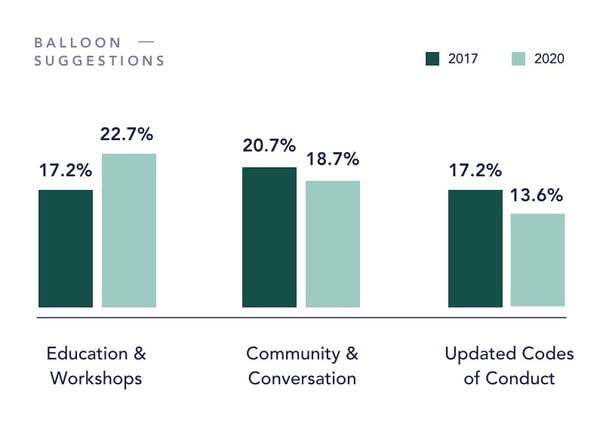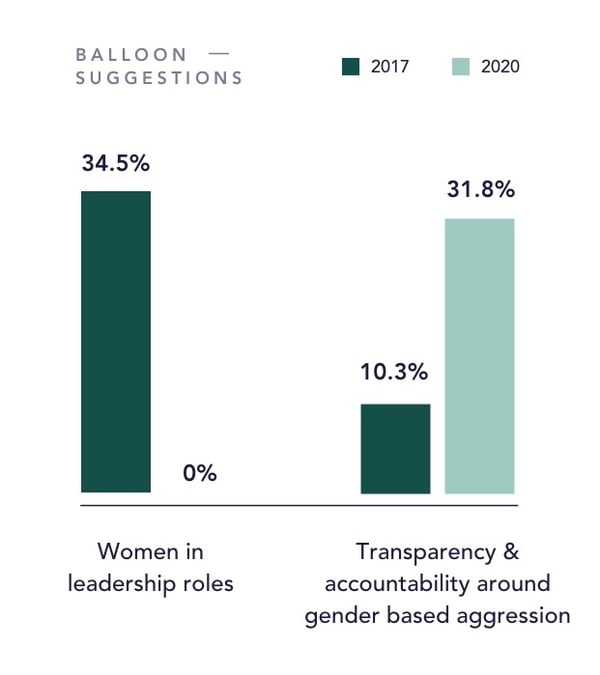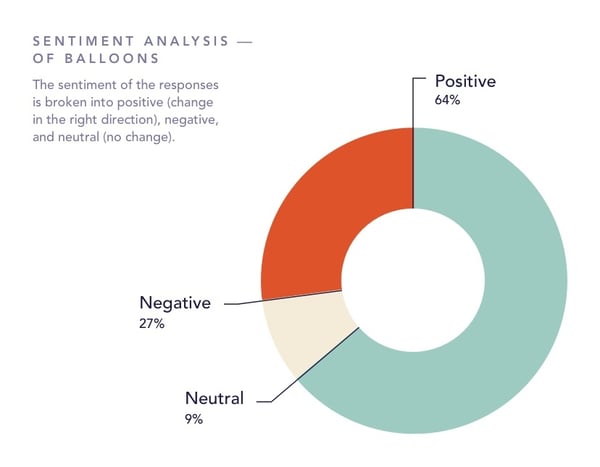The majority of participants see a rise in awareness around gender and power dynamics at work but agree the industry is still far from being systemically equitable.
Background
On September 9, the team at Balloon ran a seven- question flight that explored the effects of the #MeToo movement in the tech, venture capital, and startup spaces, three years after the hashtag was first trending in 2017. Over the course of two weeks, a variety of women entrepreneurs and investors shared their thoughts, their experiences, and their stories on Balloon.
Balloon is a collaboration platform that removes harmful group dynamics from discussions, brainstorms, and other group work. Our platform is most often used in professional settings, but it can remove cognitive biases, hierarchy, and fear for all group interactions. Because Balloon’s design streamlines asynchronous collaboration, fosters psychological safety, drives honest contributions, and amplifies unheard voices, the responses surfaced in this flight are precise, human, and true—and they illuminate the realities of how the startup space has shifted over three transformative years.
Balloon’s mission is to enable teams to harness the power of true insights, no matter where or whom those insights come from.
Balloon uses research-based solutions, including anonymity, flexible timing that allows for asynchronous work, and a unique approval voting system, to drive engagement from every team member—from introverts to extroverts, from interns to CEOs. Balloon’s UX and main process, called a Flight, is specifically designed to mitigate bias and other harmful group dynamics, foster psychological safety, and surface the most innovative ideas from every participant.
Flights, or sets of questions posed by team leaders (“flight creators”), include two stages, which can run for any length of time, avoiding time zones and scheduling conflicts and ensuring all team members can participate.
Stage one—where team members anonymously share ideas, feedback, information, or insights called “balloons”—entirely eliminates anchoring bias. This is a cognitive fallacy in which a group gives undue weight to the first pieces of information shared during a meeting, and all input shared afterwards is discussed in relation to this “anchor.” Additionally, stage one gives participants a much-needed psychologically safe space for everyone to share their input without fear of judgment, interruption, or shame. They can also toggle between Solo and Collaborate modes to comment on others’ responses without the drag of titles, pleasantries, or courtesies, which fundamentally transforms what and how information is discussed.
During stage two, participants evaluate responses—and because they are anonymous, evaluation is based solely on merit. Research in group psychology and decision-making set the foundation for Balloon’s approval voting and decision-making system, in which participants can upvote, or “pump,” as many responses as they like: +1 for balloons they connect to or agree with, and +2 for emphasis. Once the flight is complete, Balloon converts the votes for each piece of feedback into a Balloon Score, or approval ranking, so leaders and their teams can clearly see which ideas are most supported and quickly gauge alignment, offering an unprecedented degree of insight and a way to consistently avoid false starts.
From 2017 to 2020
In 2017, the team at Balloon ran a flight in direct response to the then-surging #MeToo movement, aimed at women founders, entrepreneurs, and investors in the venture capital and startup spaces. Several outlets, including CNN and Crunchbase, subsequently shared the flight’s findings, many of which reveal surprising shifts when compared to Balloon’s 2020 #MeToo follow-up flight.
The 2017 flight asked participants for possible solutions to harmful gender dynamics in the workplace, while the 2020 flight asked participants what they perceived as the biggest change. The results helped measure the difference between 2017’s ideals and 2020’s reality.
- In 2017, 17.2% participants suggested structured education and workshops to raise awareness; In 2020, 22.7% reported that reality.
- In 2017, 20.7% participants advised community- and conversation-based solutions, like listening sessions or support groups; In 2020, 18.7% reported that reality.
-
In 2017, 17.2% participants proposed updated codes of conduct; In 2020, 13.6% reported that reality.

The biggest differences between the two flights appeared in two proposed solutions: Leadership roles for women and transparency and accountability. In fact, the two results switched: The most frequent hope in 2017 became the least-reported change in 2020, while the least frequent hope in 2017 became the most-reported change this year.
- In 2017, the largest portion of participants, 34.5%, expressed the need for more women in leadership roles. 2020 showed a dramatic dissonance between hope and reality: 0% of participants noticed more women in leadership roles.
-
In 2017, the smallest portion of participants, 10.3%, expressed a need for more transparency and accountability around gender-based aggression or inappropriate interactions. However, this was the most- reported change this year:

Results
40 participants engaged in the discussion on the following seven questions.
Question 1
What is the single biggest change you’ve seen around sexual safety at work since #MeToo was first trending?
Participants thought the highest priority in 2017 was leadership roles for women. In 2020, not a single balloon mentioned this happening.
In 2017, participants thought transparency and accountability had the fewest amount of proposed solutions (balloons). In 2020, this was the largest change they’ve seen.
The rise of awareness around gender and power dynamics in professional spaces was central to 78% of responses, but many top-rated balloons cited a lack of policy or systemic changes to combat sexual harassment.
When it comes to tangible changes in workplace culture as well as codes of conduct, policies, and so on, 64% of responses expressed that recent changes have helped shift the wider culture toward a more equitable, safe workplace for women, citing instances of HR and People leaders taking gender aggression- based complaints more seriously and putting in more effort to build and implement gender-based protections.
Contrarily, 27% of responses expressed that recent changes have had adverse effects—particularly on workplace culture, interactions, and morale—noting that the #MeToo movement has raised the degree of seriousness, fear, and negative consequences for both men and women involved in gender-based incidents reported to HR.
9% of responses cited neutral experiences, or no change.
"People are too afraid to deal with an issue now. They realize there will be real consequences so in my experience are pushing things further under the rug. MeToo is great, but the response from HR and corporate companies needs to be better."
– #1 balloon
"Complaints are taken more seriously than they were in the past. There is also more thought put into the types of activities that are appropriate for team events." – #2 balloon
"It doesn't seem like much has changed, but there seems to be more awareness." – #3 balloon

Question 2
Why or why do you not feel more comfortable to report sexual harassment or gender-based aggression at work now than you did pre- #MeToo?
The top-rated balloons shared in response to this question reveal that more than 70% of women do not feel more comfortable reporting sexual harassment or gender-based aggression, citing the high risks of post-#MeToo whistleblowing.
Within that 70%, 60% felt that reporting an incident to their companies would risk their own careers.
Although I admire women who can come out and describe their experiences, it's still seen as a career- breaker, so many women will not talk publicly about their experiences, particularly for gender-based aggression or injustice where the lines are not clear.
– #1 balloon
The other 40% felt that doing so would, perhaps unfairly, risk someone else’s career.
"Something I do that I know other women do is question yourself. I think, ‘Am I being too sensitive, does this really qualify as sexual harassment?’ Now that consequences are more swift and serious, I would be afraid that a person could lose their job over something that may not have warranted it in some peoples' minds." – #2 balloon
Question 3
How or how hasn't there been a wider, cultural shift in workplace attitudes and behaviors toward sexual harassment?
The responses to this question most accurately and succinctly captured the overall sentiment of the entire flight: While there is more awareness and open dialogues around sexual harassment in the workplace, there has been little to no change that systemically combats power imbalances between men and women, gender-based microaggressions, or other inappropriate incidents.
In other words, women have seen stronger reactions to these incidents after they occur, but they have not seen companies or leaders across the industry take proactive steps to prevent them.
"I think the conversation is more in the open—but I'm not sure there's been real systemic change."
– #1 balloon
"Men are more cognizant of their behavior, but some men resent how 'politically correct' things have gotten." – #2 balloon
"I think the cultural shift is still minimal. Low hanging fruit—such as people saying inappropriate things in public—is just now being harvested, but there are still microaggressions, 'mom' assumptions, gendered roles, and more still present in many spaces, particularly in male-dominated ones." – #3 balloon
Question 4
How is remote work culture impacting gender inequality, sexual harassment, and discrimination in the workplace?
The strongest shared sentiment was unequal division of household labor, with the majority of responsibilities falling on the woman as opposed to her male partner in heterosexual households. As a result, women who work from home—and more than 60% of the American workforce now works primarily remotely since the onset of COVID-19—have less time and energy to maintain professional momentum or pursue professional opportunities. This insight appeared in more than one-third (35%) of responses, and all balloons that mentioned this idea fell in or above the 64th approval percentile.
"Women disproportionately have had to pick up the slack in their households, which means that there is less time available for work."
"I think it still falls on moms to look after their kids more than on dads, which interferes with their ability to work now that everyone is working from home."
"It’s worsening things for women in terms of inequality and discrimination, as plum assignments are being given to men due to assumptions around childcare."
Additionally, 25% of balloons shared the idea that remote working environments are widening the opportunity gap between men, especially those in more senior positions, and women at work. Several responses mentioned women and other already marginalized individuals being excluded from and ignored in remote meetings, as well as a lack of transparency around new opportunities for upward mobility within a company.
"I think remote work amplifies the culture you had in place before, so if you have issues already it’s hard to make changes remotely. The thing I would worry most about is exclusion from key meetings."
"If you aren't in the room and more likely to be discriminated against, your comments and presence is more easily ignored."
"There is less transparency when everyone is at home. You don't know what opportunities you're not getting."
Question 5
How can we keep advocacy alive as we work from home?
Because this question asks for ideas rather than anecdotes or experiences, there were fewer overlapping sentiments. That said, the top three balloons all noted a need for continual, active conversations around combating systemic gender imbalances, despite remote work environments.
"Companies must adapt to the changing needs of its female employees and remember that systemic issues don't change because we are working from home. Helping people identify what [gendered] challenges can look like in a work-from-home environment, so that they can be flagged appropriately."
– #1 balloon
"For us, again the same as it was before because we've always worked from home. We’re continuing to encourage conversations, get to know the people you work with as humans, not just employees, connect with them online, and recognize and understand their lives outside of work. The line [between work and life] has to be blurred for everyone to be comfortable and honest. Thinking that they are separate is antiquated." – #2 balloon
"We need men to better understand the unequal burdens. The onus extends beyond the workplace, because our partners have become our colleagues, although we may work in different companies." – #3 balloon
Question 6
How have women founder-investor dynamics changed in the last three years?
Half of the participants expressed that there has been little to no change around gender dynamics in the workplace since the #MeToo movement began, and the highest-rated responses all shared this sentiment.
Slightly more than one-third of responses (37.5%) did cite some shifts toward more equitable, professional relationships between investors and women founders in the startup space, but these responses had low support from the rest of the group. This illustrates that most participants agree that not much has changed since 2017, and that founder-investor dynamics have only improved for a select few.
Question 7
How do/should you address women investors who don't invest in women founders?
The responses to this question fell into two general categories: (1) The macro approach: recognize and address the root problem of systemic gender inequality without penalizing the women investors themselves, and (2) the micro approach: investigate the nuances of particular investors’ backgrounds in order to understand why individuals choose to invest this way.
Both categories included top balloons with strong support from the group. The top two balloons, both with over 57% approval, shared the former sentiment.
"Don't ‘cancel’ them!! They're just working within the system they've been given. Instead, try to have conversations with them, or just post and share content about this issue so it reaches people you might not have direct access to."
– #1 balloon
"We need to look at the VC industry as a whole and not single out individual investors. There are deal-!ow restrictions on women founders in certain industries, such as enterprise tech, IoT, supply chain, robotics, etc. If a women investor is focused on industries with low women deal-flow, it may be particularly hard." – #2 balloon
The latter sentiment arose in several other responses with moderate approval, although not in any top-rated balloons.
"It’s worth understanding why they don’t. If they have significant control in making a choice, that is something to push back on, but if they are one vote in a partnership, their support for women founders may be unsupported by the rest of the partnership."
"Assuming we are speaking about financial investors, not impact investors, it's all about eliminating bias—implicit, explicit, conscious or not."
"There needs to be enough data to show if the women investor has the power to make investment decisions (often they don't), and if the industry/scope they are investing in has enough women founders. Do these women investors give their time to helping women founders improve their pitch and messaging? How many and what type of approvals are needed at a firm to make an investment decision? Does she have any female colleagues or is she on her own? These would all be important to know before jumping to conclusions....If the data exists that a woman investor has the power to make investment decisions and has made enough investments in a pool with both male and female founders, then I would absolutely address it in a non-confrontational way. Both women investors and women founders are serious minorities in their field, and both need support."
Responses that involved more harsh approaches, like direct call-outs, public shaming, and “canceling” or blacklisting, received the least support from the group.
